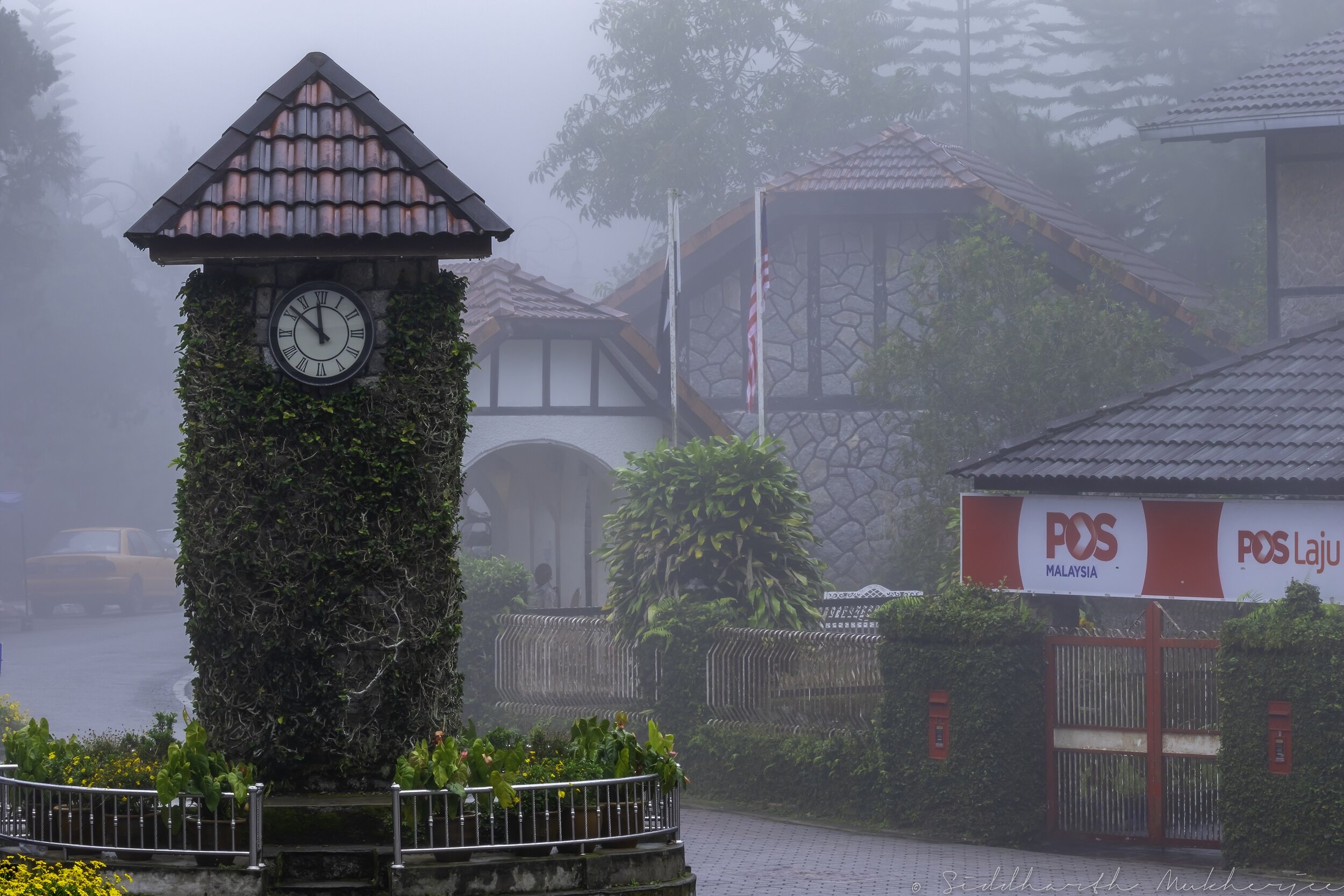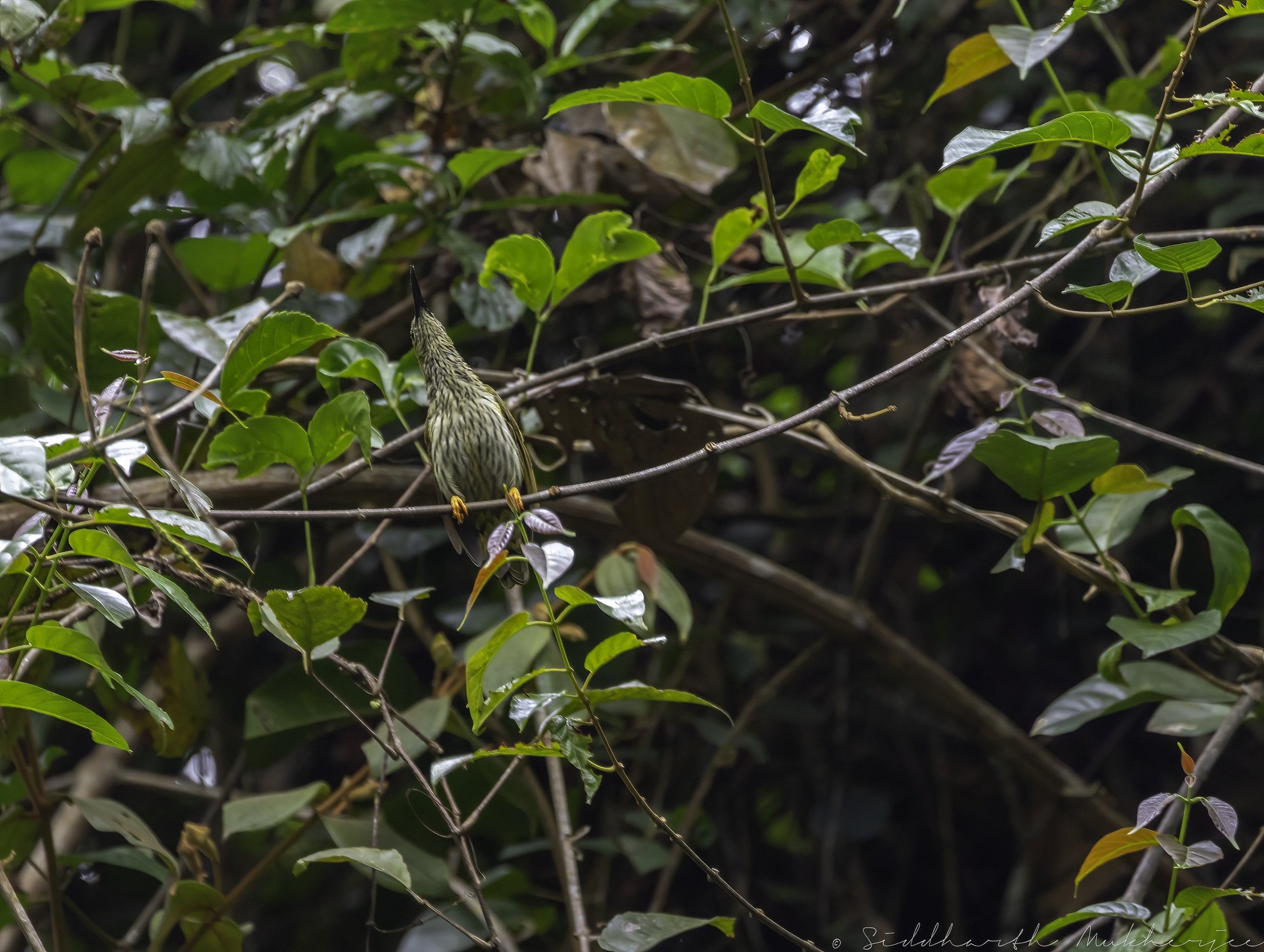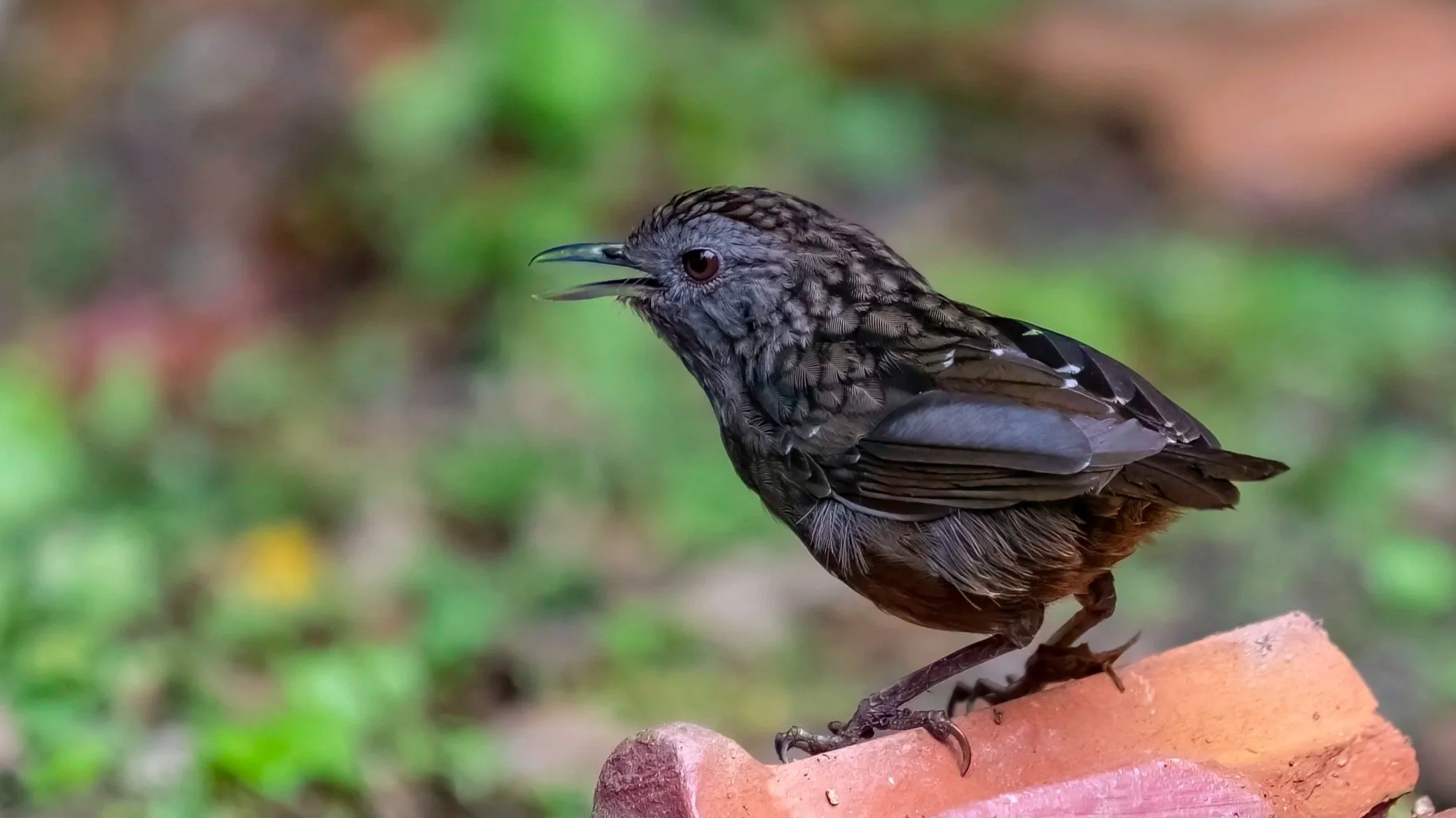Streaked Spiderhunter
Arachnothera magna
Sungai Congkak & Bukit Fraser, Malaysia
The Streaked Spiderhunter (Arachnothera magna) is a species of bird in the family Nectariniidae. Sunbirds and spiderhunters make up the family Nectariniidae of passerine birds. They are small, slender passerines from the Old World, usually with downward-curved bills and many are brightly coloured, often with iridescent feathers, particularly in the males. Many species also have especially long tail feathers. Their range extends through most of Africa to the Middle East, South Asia, South-east Asia and southern China, to Indonesia, New Guinea and northern Australia. Species diversity is highest in equatorial regions.
There are 145 species in 16 genera. Most sunbirds feed largely on nectar, but will also eat insects and spiders, especially when feeding their young. Flowers that prevent access to their nectar because of their shape (for example, very long and narrow flowers) are simply punctured at the base near the nectaries, from which the birds sip the nectar. Fruit is also part of the diet of some species. Their flight is fast and direct, thanks to their short wings.
The family ranges in size from the 5-gram black-bellied sunbird to the spectacled spiderhunter, at about 45 grams. Like the hummingbirds, sunbirds are strongly sexually dimorphic, with the males usually brilliantly plumaged in iridescent colours. In addition to this the tails of many species are longer in the males, and overall the males are larger. Sunbirds have long thin down-curved bills & brush-tipped tubular tongues, both adaptations to their nectar feeding. The spiderhunters, of the genus Arachnothera, are distinct in appearance from the other members of the family. They are typically larger than the other sunbirds, with drab brown plumage that is the same for both sexes, and long, down-curved beaks.
In metabolic behaviour similar to that of Andes hummingbirds, species of sunbirds that live at high altitudes or latitudes will enter torpor while roosting at night, lowering their body temperature and entering a state of low activity and responsiveness.
Read about the most spectacular sunbird I have seen till date - the Mrs. Gould’s Sunbird.
But first about where I first saw this beautiful spiderhunter - Bukit Fraser - one of my favourite destinations in Malaysia. Bukit Fraser or Fraser's Hill is a hill resort located on the Titiwangsa Ridge in the Raub District of Pahang, Malaysia. It is about 100 km, about a two hour drive, from the capital Kuala Lumpur and 400 km away from Singapore in the south. Known locally as Bukit Fraser, this quaint holiday retreat is popular for its nature activities and cool weather. It is one of the last hill stations of Malaysia carrying an imprint of its former British colonial masters very similar to some of the well known hill stations (winter capitals) of India.
Fraser's Hill is mountainous terrain where the altitude ranges between 320 m (1,050 ft) and 1,460 m (4,790 ft) above sea level. Around 44% of the terrain area is ranked as steep, while flat areas make up 8% of the overall land area. Fraser's Hill's virgin forest coverage is around 92% of the overall land area, with only 1.5% of the area used for a town. 6.5% of the forest area has been cleared for secondary vegetation. Ten river systems in Malaysia originate in Fraser's Hill, including Sungai Selangor, a major water source for the district of Selangor, & Sungai Teranum, which forms a major river system in eastern Pahang. The geology of the area is granite, which forms sandy, permeable soil and is easily eroded.
Fraser’s Hill has its roots in the 1890s, when Scottish prospector Louis James Fraser opened up a tin mining community known as Pamah Lebar. Mining activity there was short lived as the tin ore depleted by 1913. This led many miners & farmers to abandon the area and Fraser reportedly disappeared in 1910, but research in 2019 concluded that he retired from his position and returned to Great Britain in 1910. He died in 1916 while travelling in Austria-Hungary. An attempt in 1917 by Charles James Ferguson-Davie, the then bishop of Singapore, to locate Fraser in the area failed. While he searched for Fraser, Ferguson -Davie recognized the area's potential as a suitable location to set up a hill station and provided his suggestions to the high commissioner and chief secretary of the Federated Malay States. Its cool climate made Pamah Lebar an ideal retreat to escape from the usually hot climate in Malaysia and construction began in October 1919 to convert the mine area into a resort. The site was renamed Fraser's Hill and opened to visitors in 1922 and the erstwhile location of Fraser’s tin mine became the location of its golf course.
Subsequent development occurred in the 1970s in response to increased tourism activity. While this provided room for more visitors, it had an impact on the environment including deforestation and water pollution prompting a halt to further developments in April 2010. More species faced extinction and the water pollution affected the lives of the Orang Asli (first people) and residents in nearby villages. These issues led to the Pahang state government ruling out further development in the virgin forest at Fraser's Hill on 13 April 2010.
Fraser's Hill is known for its vast biodiversity which attracts scientists & researchers. In recent years, it has seen an increase in tourist activities including hiking, cycling, golfing, archery, riding, tennis, swimming and squash. With its tiny population of 1,000, as recorded in 2013, it is one of Malaysia’s most unexpectedly satisfying short-stay destinations. Navigating up the tight twists and turns of the road to this hill station is a stimulating experience – in fact the uphill road is so narrow that the final eight kilometre stretch is limited to one-way traffic at any time. The direction changes every hour; odd hours are for ascending the hill, while even hours have been denoted for descending traffic. With a majority of its buildings featuring mock Tudor-style architecture, Fraser’s Hill hasn’t changed much from its days as a British colonial hill resort. Besides the essential photo stop opportunity at Fraser’s Clocktower, a hard-to-miss clock tower which stands in the old English village square, you can head on down to Allen’s Water, a former reservoir turned into a boating and fishing attraction.
Akin to a tiny Scottish hamlet, Fraser’s Hill is one of Malaysia’s premier locations for bird-watching. Avid bird watchers can take advantage of the fact that Fraser’s Hill is home to over 250 species of birds – the Fraser’s Hill Development Corporation and the World Wildlife Fund both run classes and excursions to see the flora and wildlife of the hill station. What's more, the Fraser’s Hill International Bird Race – a contest to document the vast variety of birdlife on the mountainside – is typically held here in June. There are eight nature walk trails available ranging from easy to hard. For example the Maxwell Trail – a short and easy hike or the six-kilometre Pine Tree Trail – a longer trail that takes one past some dramatic views and ends near the 18 foot Jeriau Waterfall located about five kilo metres from the town centre. Fraser’s also plays host to the Royal Fraser’s Hill Golf Course – a nine-hole green that is one of Malaysia’s oldest. There’s also a paddock at the eastern edge of the course where one can saddle up for a horse riding session.
Read about my other birds from this beautiful hill station. These are only a few of the huge number I have spotted and recorded there.
With that said, meet this beautiful spiderhunter from Fraser’s Hill. We spotted the bird in the foliage a little behind the clock tower seen above.
‡‡‡‡‡
Streaked Spiderhunter
The Streaked Spiderhunter (Arachnothera magna) is a species of bird in the family Nectariniidae. Sunbirds and spiderhunters make up the family Nectariniidae of passerine birds. They are small, slender passerines from the Old World, usually with downward-curved bills and many are brightly coloured, often with iridescent feathers, particularly in the males. Many species also have especially long tail feathers. Their range extends through most of Africa to the Middle East, South Asia, South-east Asia and southern China, to Indonesia, New Guinea and northern Australia. Species diversity is highest in equatorial regions.
There are 145 species in 16 genera. Most sunbirds feed largely on nectar, but will also eat insects and spiders, especially when feeding their young. Flowers that prevent access to their nectar because of their shape (for example, very long and narrow flowers) are simply punctured at the base near the nectaries, from which the birds sip the nectar. Fruit is also part of the diet of some species. Their flight is fast and direct, thanks to their short wings.
The family ranges in size from the 5-gram black-bellied sunbird to the spectacled spiderhunter, at about 45 grams.
The Streaked Spiderhunter, however, is a large and noisy inhabitant of tropical and subtropical hill forests. It is a distinctive large spiderhunter with a long, curved black bill and black streaking all over its yellow-green upperparts and lighter yellow underparts. It gleans invertebrates from foliage, but also hovers around and probes into flowers for nectar. It is often seen moving with mixed flocks, calling frequently, giving a loud, decisive-sounding “chitick, chitick!”.
Similar in size to a sparrow, it is olive yellow in color, with multiple darker streaks. It has a long, curved black beak and yellow legs. Below, it is pale yellow streaked with black. Its beak is specially adapted for a nectar diet.
It is found in Bangladesh, Bhutan, Cambodia, China, India, Laos, Malaysia, Myanmar, Nepal, Thailand, & Vietnam. In India, it is found in the Eastern Indian states. Its natural habitats are subtropical or tropical moist lowland forest and montane forest.
This species can be found alone or in pairs. The nesting season is from March to July. The nest is usually made of leaves that are tied together with cobwebs, and they are found attached to the reverse side of a leaf.
The following gallery of the streaked spiderhunter is a bird observed & photographed near the Bishop’s trail at Bukit Fraser. The photos are from various trips I have made to this quaint little village town.
‡‡‡‡‡
Related Posts






















